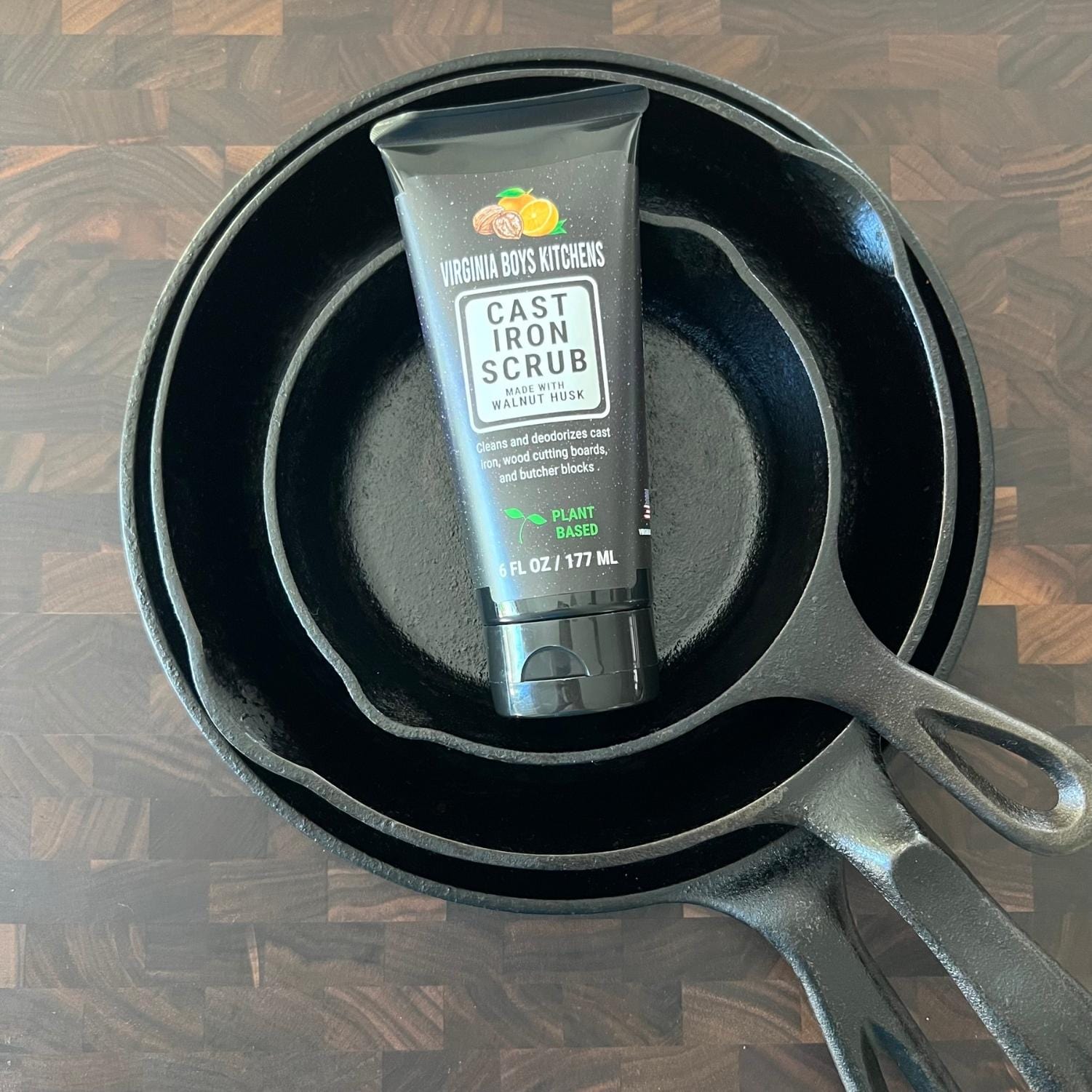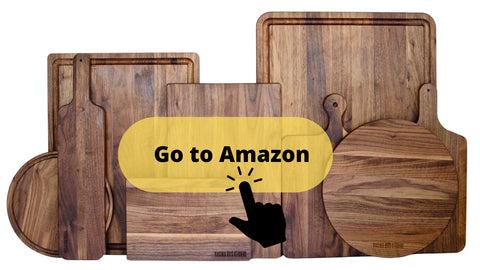Cast iron pans are simply the best when it comes to cooking. Our ancestors used them daily with success for decades. However, in recent years, many people have tossed cast iron in favor of other pans. Their reasoning?? Cast iron is too difficult to care for. Well, we can tell you that cast iron isn’t difficult to care for. Seasoning cast iron is a simple process, even if you don’t want to put the pan in the oven. Today, we are going to share how you can season cast iron without an oven.
What is Cast Iron Cookware?
Before we get to the seasoning part, we thought we should share exactly what cast iron cookware is. This cookware is cast from iron. The iron is durable and can handle high temperatures. You can use this cookware in kitchens and even on open fires. This is why it is considered so versatile.
There is no limit to what you can cook using cast iron cookware. You can cook breakfast items like bacon and eggs. Grilled cheese, deep dish pizzas, steaks, and chocolate chip cookie cakes are also foods that can be cooked in these pans.
Just be careful the cheese doesn’t ooze out of your sandwich. The reason for this is foods like cheese, fish, and peppers will be absorbed by the pan and the flavors will be added to the next thing you cook.
Acidic foods can cause discoloration to cast iron occasionally. Therefore, some people will not cook those foods in these pans either.
How Cast-Iron Cookware is Made
Cast iron cookware can seem expensive to those who have no idea what goes into the process of making it. To make a cast iron pan, iron casters mix melted iron and steel blocks together. Other chemicals are added to the mix to raise the carbon levels. The entire mixture is then poured into a mold made from sand.
As soon as the cast iron skillet has cooled in the mold, the mold is broken.
The higher the quality of materials used to make the cast iron cookware, the higher the price. Keep that in mind when you are purchasing cast iron pans. A cheaper price will automatically mean a cheaper quality pan.
The History of Cast Iron Cookware
The very first patent for the sand mold used for casting this cookware was obtained by Abraham Darby in 1707. The method he used is quite similar to the method that is still used today.
While the use of these pans soared in the 18th and 19th centuries, their use declined in the 20th century. Probably for the reasons we mentioned above.
Now that enameled cast iron is available, people are starting to be interested in this type of cookware once again. Everyone can purchase cast iron enameled pans that match their kitchen décor.
It is important to note that enameled cast iron skillets cannot be used over campfires. The enamel can melt and become damaged from the high heat of the fire.
How to Remove Rust from Cast Iron
We are getting closer to learning how to season cast iron without an oven. But first, you need to know how to remove rust and how to prepare this pan for seasoning.
Removing the rust from cast iron can seem intimidating and difficult. However, the process is simple. It can be time consuming though if you have a cast iron skillet with a lot of rust.
Begin by using a scraper to remove the rust. Then wash the cast iron with dish soap. Use a scouring pad to remove any last bits of rust. Steel wool or a sheet of aluminum foil rolled into a ball can be used if you do not have a scouring pad. Rinse the dish soap off completely and then dry the cast iron with a cloth or paper towel.
You can also purchase cast iron cleaner with a scrubber to ensure you are using the proper items to clean your cast iron. Our Virginia Boys Kitchens cast iron scrubber is a cleaner that deeps clean, and is made with real walnut husks that helps give your cast iron a good scrubbing - scented with fresh orange scent!
At this point, you will need to finish drying the cast iron pan before seasoning it. To do this, simply place it on a range burner and heat it on low until it is completely dry. You can also use a dry cloth to get most of the water off the cast iron skillet.
How to Prepare Your Cast Iron for Seasoning
If you do not have any rust on your cast iron, or you purchased a new pre-seasoned cast iron pan, you need to know how to prepare your cast iron for seasoning. The seasoning process is not difficult.
Start by thoroughly washing your cast iron pan with soapy water. This is especially important if you purchase a cast iron pan that has a layer of wax. That wax must be removed, so it does not contaminate your food. And if you don’t really care about that, it is important to mention that the wax will also prevent your oil from bonding with the pan. Which means it won’t season with the wax on it.
So, basically, you must remove the wax if you purchase cast iron cookware with it on!
Older pans will need any dirt and stuck-on food removed from the surface. You should also remove all baked-on stains and food particles. This will ensure a better seasoning. If the food seems to be stuck in the cast iron pan, simply add salt to the pan and scrub it out under hot water.
After your pan is thoroughly dry, it will be ready to season.
How to Season Cast Iron Without Oven
Now that you are ready to season your rust-free cast iron, it is time to learn how to season cast iron without an oven.
Start by coating your cast iron with a thin coat of oil of your choice. Then turn on the burner you want to use on your stove top. The cooking surface should be on medium or medium high heat. Place the cast iron on top of the burner. The cast iron will need to stay on the burner for at least 10 minutes.
It is important to stay in the kitchen during this process. It is common for the smoke alarm to go off from the smoke that is created from the oil, as the pan is on the cooking surface. Turning the fan on over the stove can be helpful, but you may still have a kitchen full of smoke.
After the 10 minutes, you will want to make sure your cast iron pan is dry. If it isn’t, you will need to leave the pan on the burner a little longer.
Depending on the seasoning level of your cast iron, you may need to repeat these steps a few times with additional oil layers to achieve the seasoning level you desire. Simply make sure you cool your cast iron completely in between seasonings.
As you continue with these seasoning methods, you will notice the rough surface of your cast iron skillet will turn into a smooth surface. This change in the surface means your pan is getting the natural non-stick surface you desire.
If you do not have a stove top, you can also season cast iron on a grill. Simply preheat your grill and place the cast iron on the grate. Then follow the directions we mentioned for the stove top option above.
How to Choose the Oil for Cast Iron Seasoning
Above, we mentioned choosing a cooking oil for seasoning your cast iron. If you are unsure of which oil to use, we have you covered. We recommend using oil that is high in unsaturated fat. These types of oils bond better with cast iron during the seasoning process.
Avocado and grapeseed oils have a high smoke point. If you use those, you can season your cast iron faster at a higher temperature. Vegetable, coconut, corn, and soybean oils are also an option. You can also purchase cast iron seasoning oil, so you never need to worry whether or not you are using the best oil for your cast iron pan.
We also should mention that you will want to be careful if you choose to use a flavored oil. The flavor of the oil will soak into the pan and then be present in anything you cook in that pan in the future.
When to Season Cast Iron
Most cast iron is pre-seasoned, but that doesn’t mean you should skip the seasoning process on your pan when you get it home. An initial seasoning is always recommended even on pre-seasoned cast iron skillets. Seasoning it yourself means it will truly be a nonstick surface when you use it the first time, because it will have a protective coating.
After you use your cast iron pan, you will want to season it once a month. Or more often if you notice food is sticking to it when you are using it. Remember, a well-seasoned cast iron pan is always going to have a natural non-stick surface.
Using your cast iron daily will ensure the seasoning on your pan is reinforced constantly. This is why regular care of your cast iron skillet is necessary. However, if you do not use your cast iron for a while, the seasoning will turn rancid. The pan can even start to rust from unuse. If that happens, follow the steps above to remove the rust and re-season your cast iron.
When you do not plan on using your cast iron for a few days or longer, it is important to store it properly to avoid it getting rusted. We recommend making sure the cast iron pan is completely dry. You should never stack cast iron pans. Try to avoid storing it in a place where humidity is present too.
How to Care for Cast Iron

Every time you use your cast iron pan, you should clean it immediately after you are finished using it. Simply use a little hot water to remove any food and dry thoroughly. Then add a thin layer of oil, as additional seasoning, and rub it in with a paper towel, so the pan is still dry. You can then store your cast iron until you use it the next time.
Adding that layer of oil every time isn’t always necessary. However, it will prevent rust from forming and ensure your pan is thoroughly seasoned when you want to use it.
Now that you know how to care for cast iron, as well as how to season cast iron without oven, you are more than ready to start cooking with these pans. You will be thrilled with how easy these pans are to use when they are seasoned properly. Purchase your very own cast iron cookware today or take out those cast iron pans that are in storage. Then use what you learned today to get those pans ready to use when you make your next meal.
See Virginia Boys Kitchens On Amazon
We are on Amazon, see our storefront here. Use coupon code VBKBLOG10 for 10% off your entire purchase of any Virginia Boys Kitchens on Amazon. Apply the code at checkout.





